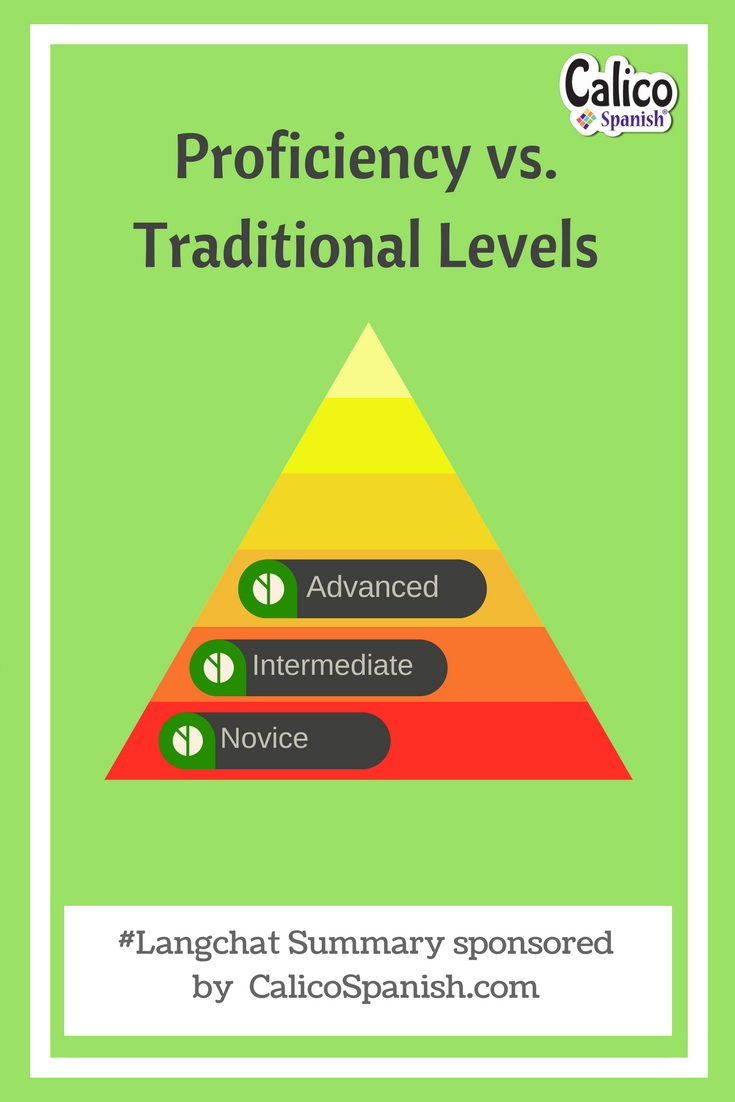Spanish 1? Novice French? Proficiency vs. Traditional Labels
 How can teachers address proficiency targets while engaging a range of students in traditionally-labeled language levels? This challenge was a reoccurring theme discussed in last week’s #langchat on how traditional world language levels align with proficiency levels. However, #langchat participants shared their strategies for integrating both concepts in the classroom.
How can teachers address proficiency targets while engaging a range of students in traditionally-labeled language levels? This challenge was a reoccurring theme discussed in last week’s #langchat on how traditional world language levels align with proficiency levels. However, #langchat participants shared their strategies for integrating both concepts in the classroom.
– Follow the blog on Bloglovin –
Proficiency Targets & Performance Expectations
Defining what it means to be proficient in various language levels is no easy task. For some, exchanging ‘proficiency targets’ with ‘performance expectations’ seemed to make more sense. Keep in mind that ACTFL proficiency standards measure a speaker’s overall oral proficiency, while the teacher assessing a student in the classroom is measuring that learner’s performance on a particular task, and making this distinction dominated the first part of this #langchat.
What is proficiency?
@SraSpanglish said, “I think when we say proficiency, we’re talking in generalizations based on performances”. @MmeCarbonneau added, “For me, proficiency is what they remember long after the performance has come and gone.” @doriecp said:
Proficiency is also a wide range of topics (both formally studied and not) while performance is only what you’ve practiced.
Level labels Vs. Time Spent in the Classroom
Correlation between students’ proficiency levels and time spent within the classroom is evident for many #langchat teachers. @growingFrench teaches on a “Year-long block schedule” while aiming for the following proficiency levels: “End of Middle School = Intermediate Low, (French II) end of French IV = Intermediate High.” @senioritawoodteaches, “6th 2 days/week, 7th 3 days/week, 8th 4 days/week for 45 min. My target ?for [the] end of 8th grade is Novice High.”@Sra_Kennedy said, “I see my #earlylang [students] every other day for 25 [minutes]. My target is Novice Mid with some getting to Novice High but only if they’re there K-5.”#Langchat participants agreed that the longer students spent in the classroom, the higher their achievement. Consistent contact time with students is not something teachers can always control. However, @mlleSulewski kept the chat positive:
Let us not forget that true acquisition can be a slooooooow process.
– Like Calico Spanish on Facebook –
Addressing Variations in Proficiency Targets Across Programs & Courses
A common reason for variations in proficiency across programs is that students do not all learn at the same pace and often have different language backgrounds and learning abilities. According to @BThompsonEdu, differentiation is a reason for varying proficiency levels; it is important to remember that, “everyone doesn’t need to be at the same place at the same time to improve.”
#Langchat teachers determined the following reasons for variation in language proficiency among students:
- @languagehead said, “- [Different] languages will require [different] contact time to reach same [proficiency] level!”
- According to @magisterb480
It all depends on the students you have in your class. Work to their abilities, not where you think they should be.
- @ADiazMora said, “Motivation is big too; in my area, some students have skipped levels not because they needed to, but [because they] wanted to, and now they [are] suffering.”
- @SrMcMaine included, “student background [and] early [language] exposure”as significant factors for variation in language proficiency.
– Follow Calico Spanish on Twitter –
Meeting individual students at various proficiency levels within a class can be challenging. However, language teachers are finding strategic ways to accomplish this task.
- @kballestrini advises teachers to “provide multiple avenues to demonstrate comprehension at various levels.”
- “Teach to the middle but reach for the sky,” said @MrM0REHEAD.
- @GrowingFrench said, “I have flexibility with placement, but I also grade on individual proficiency goals.”
- @senoritawood said, “Meeting your [students] where they are [at]is a factor. I’ve found this [year] that I am able to do more with them the less I use the textbook.”
Tips for Assessing Performance Benchmarks
#Langchat teachers gave advice on how they can assess performance benchmarks.
- Tjeag uses, “Tasks designed with target in mind.[Students] must be able to explain what [proficiency] looks like at the target level, below and above it.”
- MmeBlouwolff uses a “presentational writing task (announced, on-demand) at end of each big unit (there are 4/year).”
- MrM0REHEAD uses the “AAPPL test.[I] can’t afford to test all 200+ [students], but try to find a sample group that represents Low, Mid& High flyers + demographics.”
– Follow us on Instagram too! –
Thank You
Thank you to all #langchat participants for contributing and sharing your insight and successful classroom techniques.Thanks to Meredith (@PRHSspanish) for leading this insightful chat on how proficiency levels align with traditional levels of world language classes, and to her support moderators, Megan (@MlleSulewski) and Laura (SraSpanglish). Have a topic you’d like to discuss? Don’t forget to check out the #langchat wiki and suggest a topic!






No Comments